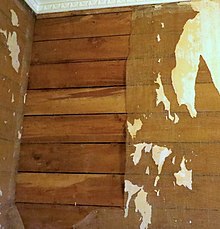

Scrim and sarking is a method of interior construction widely used in Australia and New Zealand in the late 19th and early 20th centuries. In this method, wooden panels were nailed over the beams and joists of a house frame, and a heavy, loosely woven cloth, called scrim, was then stapled or tacked over the wood panels. This construction method allowed wallpaper to be applied directly.
In New Zealand, the sarking was often the native rimu (red pine), and the scrim was usually either jute or hessian. It is easy to tell whether walls have scrim and sarking as their basis: knocking on the wall produces the sound of the wood, and any wallpaper laid over the top has an uneven finish. In many instances, the scrim will come loose from the sarking, in which case the wallpaper will appear to float loose from the wall.
Disuse
Compared with more modern forms of interior wall surfacing, scrim and sarking has poor insulation properties and can encourage damp. It is also more costly to insure homes with scrim and sarking walls, as they pose a fire danger. For these reasons, home renovation will often see it replaced with gypsum-based wallboards.
References
- ^ "What is scrim and sarking?", propertytoolbox.co.nz. Retrieved 16 September 2019.
- ^ "A short history of the Gib crisis", Victoria University. Retrieved 03 March 2024.
- Bolton, J., "Risk with houses built before 1945", squirrel.co.nz, 28 January 2012. Retrieved 16 September 2019.
This material-related article is a stub. You can help Misplaced Pages by expanding it. |